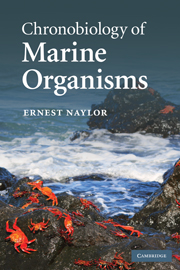Book contents
- Frontmatter
- Contents
- Preface
- 1 Moonshine
- 2 Biorhythms of coastal organisms
- 3 Tidal and daily time-cues
- 4 Clocks and compasses
- 5 Lunar and semilunar biorhythms
- 6 Annual biorhythms
- 7 Plankton vertical migration rhythms
- 8 Staying put in estuaries
- 9 Ocean drifters
- 10 Living clockwork
- References
- Author index
- Subject index
- Plate section
8 - Staying put in estuaries
Published online by Cambridge University Press: 05 June 2012
- Frontmatter
- Contents
- Preface
- 1 Moonshine
- 2 Biorhythms of coastal organisms
- 3 Tidal and daily time-cues
- 4 Clocks and compasses
- 5 Lunar and semilunar biorhythms
- 6 Annual biorhythms
- 7 Plankton vertical migration rhythms
- 8 Staying put in estuaries
- 9 Ocean drifters
- 10 Living clockwork
- References
- Author index
- Subject index
- Plate section
Summary
…the estuarine environment is more extreme, and undergoes more violent fluctuations than the open sea or freshwater habitats.
Eric Perkins, 1974Throughout the world, where rivers flow into the sea and meet the pulsing of ocean tides, living conditions are hazardous for aquatic organisms. Marine fish such as salmon which enter freshwater to spawn, and freshwater eels that spawn in the sea, face the problems head on as they move through the admixture zone where salt and fresh waters meet. Such anadromous and catadromous migrants have evolved physiological mechanisms by which they are able to cope with dramatic changes in water flows and the rapid uptake or loss of salt and water to which they are exposed, depending upon their direction of travel through the salt and freshwater interface (Davenport, 1985a, b). Fully marine or freshwater animals do not have such compensatory mechanisms so, if they are inadvertently carried into the admixture zone, their survival is threatened. However, some opportunistic species have successfully colonized estuarine habitats, permanently overcoming the problems of fluctuating salinity, temperature and water movements to become estuarine residents. Some macroalgae are specific to estuaries, remaining attached to rocky outcrops, quays and piers, and large populations of microalgae are to be found in the upper layers of mudflats, some migrating deeper at night under the control of biological clockwork, as discussed in Chapter 2.
- Type
- Chapter
- Information
- Chronobiology of Marine Organisms , pp. 150 - 165Publisher: Cambridge University PressPrint publication year: 2010



